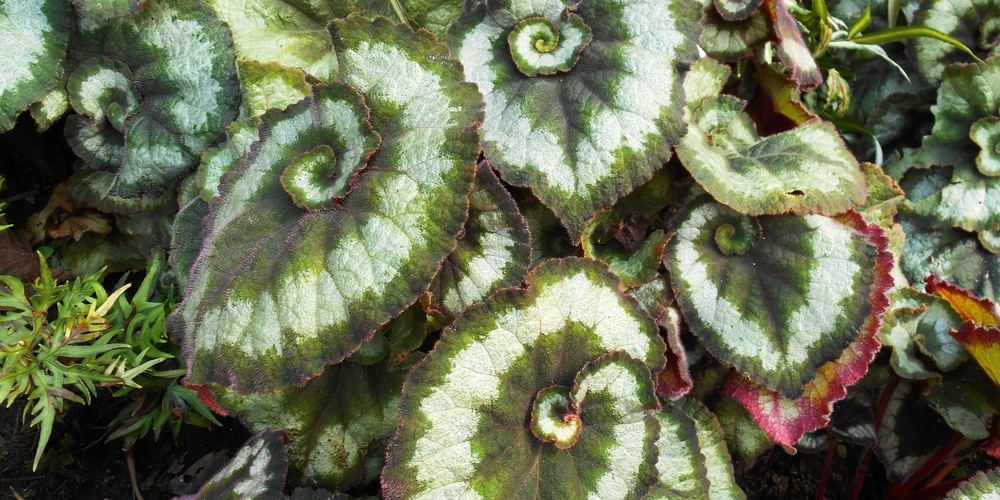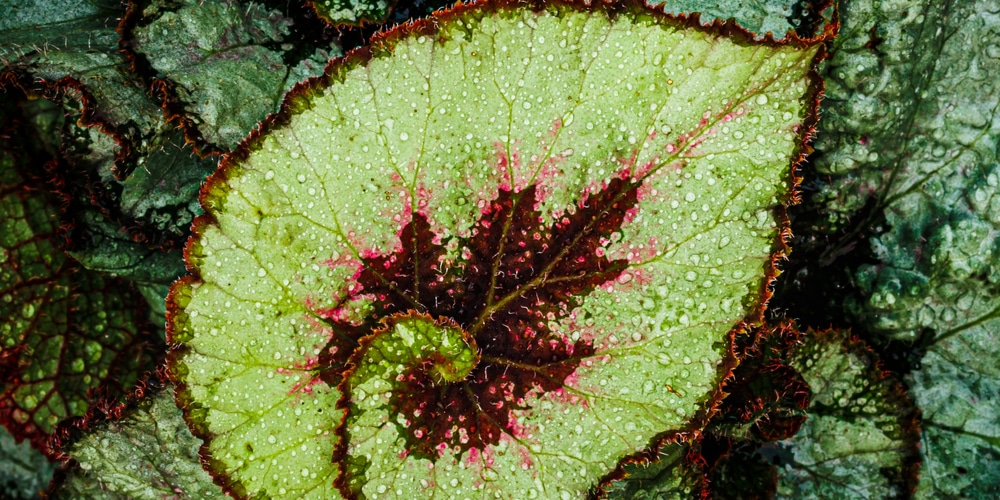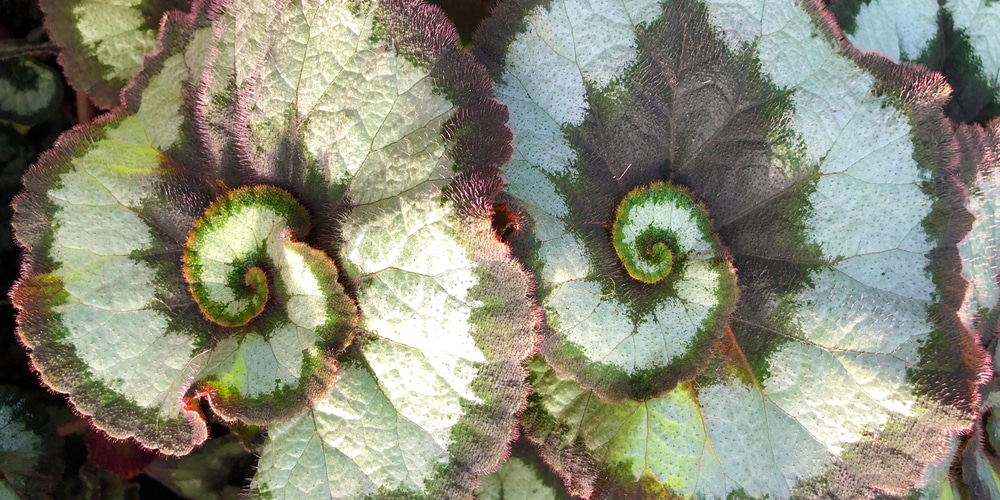Begonia escargot is a Rex Begonia hybrid native to the tropical forests of southeast Asia. It is an elegant house plant, perfect for adding greenery to your interiors. Alternatively, you can grow it outdoors, provided that you live in a warm enough area. If you wonder what gives this plant its funny name, the answer is simple. This plant’s stunning foliage develops in spiral patterns resembling snails.
Contrary to what you may be thinking, this delicate-looking plant is relatively low maintenance. But to learn more about Begonia Escargot, read on! Here, you’ll find everything you should know about this stunning houseplant.
| Botanical Name | Rex Cultorum Begonias |
| Common Name | Begonia Escargot |
| Plant Type | Perennial |
| Flower Color | Pale pink flowers, small. |
| Size When Mature | Between 6-12 inches |
| Bloom Time | Early Summer to Fall |
| Sun Requirements | Partial shade or bright, indirect light |
| USDA Hardiness Zones | 10-11 |
| Soil PH Range | 5.7 – 6.2 |
| Soil Type | Light, loose, well-draining, slightly acidic |
| Water Needs | Medium (prefer moisture, but don’t like soggy conditions) |
| Native Area | Tropical forests of southeast Asia |
What you Need to Know About Begonia Escargot
The most striking characteristic of this plant is its variegated green, silver, and chocolate leaves growing into a spiral. While this type of begonia flowers too, its pink blooms are just an additional benefit (that you can enjoy between June and October). For even more dramatic effects, you can consider combining your Begonia Escargot with other colorful plants: the result will be breath-taking.
Keep your plants out of your pets’ and kids’ reach. Begonias can be poisonous to cats and dogs (and can be harmful to humans too when ingested). After munching on their leaves, your pets might experience a severe reaction. Indeed, these plants cause stomach discomfort and might provoke vomiting and diarrhea.
How to Care for Begonia Escargot
So, we said that taking care of Begonia Escargot is not as challenging as you think. But that doesn’t mean you won’t have to pay attention to its requirements. Don’t worry. You’ll find everything you need to know about growing Begonia Escargot in the following sections.
Light
These stunning plants perform best in partial sunlight or under indirect bright light. Protect them from the harsh rays of the sun. Because of their native environments (where they live in the cover of tall trees and lush plants), these plants have a low tolerance for direct lighting.
Too much sunlight might burn its beautiful leaves and even cause discoloration. So, if you are growing this plant indoors, there is no need to place it next to a window. However, keep in mind that, like all plants, your Begonia escargot still needs some light. Locate its container in the middle of a bright room to get the best lighting.
If you prefer planting your Begonia Escargots outside, place them under partial shade. The ideal situation should allow your plant to enjoy the morning sun but avoid the harsh afternoon hours.
Water and Soil Needs
Begonia Escargots thrive in moist environments. You will have to increase watering frequency during spring and summer (even more if your plants grow outdoors). Slow down your schedule as development halts in the winter, when your plant goes dormant and stops growing. So, it doesn’t need as much nutrition.
Feel the soil with your fingers to ensure you give your plant enough water (and not too much). You should only water your begonia if the top one to two inches feel dry.
These plants aren’t too picky in terms of soil. However, they grow better in light, rich, and well-draining soil. The idea is to be able to water your plants without letting them wet for too long, as begonias are susceptible to root rot and fungal infections. Choose a high-quality potting mix and add peat moss and perlite to increase drainage and improve the nutrient content.
If you planted your Escargot Begonias outdoors, add some mulch to the ground to regulate the temperature around your plants and keep them moist for longer.
Temperature Requirements
As we mentioned, Escargot Begonias are tropical plants. For this reason, they enjoy warm climates, better if humid. You can grow them outdoors as perennials in USDA hardiness zones between 10 and 11. Anywhere else, they perform better as indoor plants.
The optimal temperature for these plants is between 65 and 75°F. However, your begonia will tolerate conditions as high as 90°F, if necessary. But above that or below 55°F, your plant will struggle.
Humidity is crucial when growing these plants. Keep the levels at or above 50% for happy begonias escargots. You can get a humidifier to recreate the optimal conditions for your begonias’ growth.
Also, it is always a good idea to mist your plant’s leaves from time to time to increase moisture in the environment surrounding them. Alternatively, you can make a pebble tray to improve water retention in our plant. If you don’t want to mess up with humidity, consider getting a digital hygrometer to measure the conditions fast and adjust your actions accordingly.
Fertilizer
Begonia Escargots are not heavy feeders. Still, they will benefit from the addition of a balanced fertilizer in spring and summer. Adding a suitable product to your plants will encourage leaf growth and keep your plant healthy. Avoid applying too much fertilizer, as you might get opposite results.
Common Diseases
With these types of begonias, you must be wary of overwatering. Too much water can cause severe damage to your plant’s roots. Avoid root rot, which will cause your begonia to die and attract fungal infections. Plus, keep an eye out for aphids, mites, caterpillars, and mealybugs. As soon as you notice these insects, apply a proper pesticide.
Begonia Escargot Propagation
If you want to create more begonia escargots from your mother plant, you can do so by propagating your plants. The most effective method is doing so from cuttings. Cut a healthy stem (with a few leaves on and without flowers) and insert it in a jar with water. Change the liquid regularly and relocate your plant to a pot with a well-draining soil mixture as soon as you notice some roots developing. You’ll get the first sprouts in as little as a couple of months.
Alternatively, you can propagate your plants using the method of leaf cuttings. Only choose a healthy-looking leaf, cut it across its veins, and press all the pieces you create down to the soil. You’ll start seeing some growth in about six to eight weeks.
How to Prune Begonia Escargot
Adding Begonia Escargot to your house or garden is ideal if you want to add an elegant touch to your property without worrying too much about taking care of your plants. If you provide these plants with what they need to survive, you won’t have much else to do to maintain them healthy.
If you feel your begonia growing denser than you like, you can prune your plant. Pinching off leggy stems and removing dead and unhealthy-looking branches or leaves will help you control your plant’s size and keep it in an attractive shape. Plus, it is an excellent way to prevent the spread of diseases. And the good news is that it doesn’t take much time to do so.


